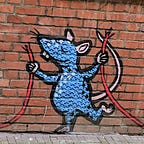Viaje a Espagña — Toledo
The small mountaintop city of Toledo, Spain enjoyed outsize clout from Roman times until the 1560s, when King Philip II, flush with gold from the Americas, moved the capital to Madrid. Toledo stagnated for centuries, which eventually proved a gift: its medieval ambiance today attracts cash-wielding tourists from across the world, including us.
The cathedral is the city’s main attraction, but we looked first for another landmark: the Starbucks on Calle Comercial. Why? Because The Fabulous Wife is from the sister city of Toledo, Ohio, and across from the Starbucks there’s a street now called Calle de Toledo de Ohio. We had to see that!
Then we went to the cathedral, except it was temporarily closed because they were using it for an actual religious service. So we went to an old synagogue instead.
Toledo is a great place to experience the Middle-Age confluence of Islam, Christianity, and Judaism. Okay, maybe not so much Judaism. Ferdinand and Isabella banished the Jews in 1492, the same year they wished Columbus well on his westward sail to India. Today there are only 25,000 Jews in Spain, most of them in or near Barcelona.
To me being Jewish is like being white or American: an accident of birth, and therefore something to be neither proud nor ashamed of. But I was in a land that persecuted people of my faith for centuries, and here it was marketing to me! There were signs pointing to the old Jewish Quarter, ceramic tiles in the cobblestoned streets inscribed with the Hebrew words chai (life) and sefarad (Spanish Jews), and seven-candle menorahs available for purchase in souvenir shops.
I wasn’t sure what to think until we visited the Santa Maria la Blanca Monumento Nacional — site of a twelfth century synagogue. The structure had been a mosque before it was a synagogue, and it became a Roman Catholic church after the Jews were expelled. When I looked for distinctly Jewish features, though, I didn’t find any, whereas I readily found distinctly Islamic and Christian features:
Spain has been good about acknowledging ancient wrongs; The Fabulous Wife checked the internets and learned that if Jewish people can prove descent from an expelled forebear, they’re entitled to Spanish citizenship without having to renounce their current citizenship. But as the visit to the synagogue showed, there remain few genuine traces of Spain’s Jewish communities. The welcome to modern Jews, though heartfelt, is hollow. How likely is anyone to successfully document their genealogical line going back half a millennium? And a souvenir menorah doesn’t erase the Inquisition.
So is now is a good time to mention how thoroughly I enjoyed Spain’s cathedrals?
Once Roman Catholicism triumphed in Spain, the country’s artists and craftsmen went all out embellishing its cathedrals. This is just one part of the organ in the Toledo cathedral:
The whole place is like this — ornate, sumptuous, fantastical. The eighty-foot altar is so stunningly detailed no photo can do it justice. A smaller altar, the Transparente, so named because a hole was cut in the cathedral’s ceiling for the morning sun to shine on it, also defies photography, but here’s a piece of it. Try counting all the faces:
I also love the sound in cathedrals. A hundred conversations bouncing off the hard surfaces meld into white noise as they rise toward the vaulted ceiling, making it easy to meditate in the vast, cool, darkened space. Toledo became one of several Spanish cathedrals where I realized that (1) I’d have been burned at the stake had I entered five hundred years earlier, but more importantly (2) regardless of sectarian trappings, I’m comfortable anywhere art and spiritual longing (free of dogmatic rigidity) combine.
